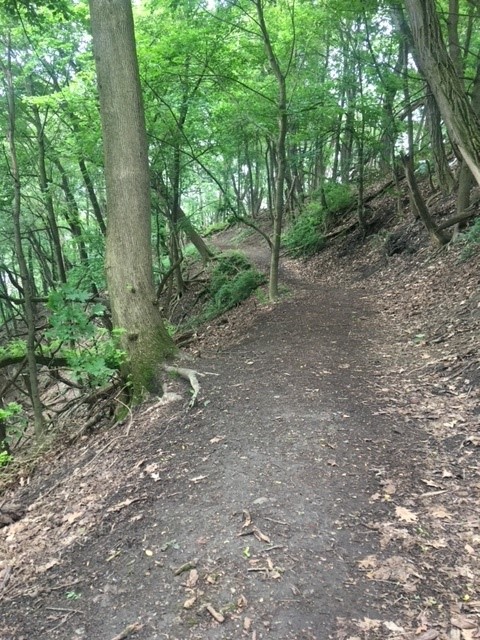
Do you want to trail run safely or wondering how you can get better at trail running? A coach would be great, but I’ve found using a heart rate monitor can be a great alternative and a lot more convenient.
In general, monitoring your heart rate to target specific training zones when trail running can make you a better runner. A heart rate monitor can be used as a guide to adjust one’s pace and effort due to changes in terrain and elevation. It provides objective feedback to optimize fitness and running performance while reducing the risk of injury.
Trail running presents some interesting challenges from traditional road or track running. To get the most benefit from your runs, learning how to use your heart rate monitor can enhance your performance. Read on for 9 basic steps on using a heart rate monitor when trail running to keep you running optimally and safely.
1. Determine Your Max Heart Rate
You need to know what your max heart rate is first. Heart rates differ based on several factors such as age, gender, fitness level, genetics and more so each person’s max heart rate can vary widely.
There are two basic ways, a field test or a calculation, for determining a max heart rate. Each method has pros and cons, but they both can give you a good ballpark number to start with.
A field test is a running test and is generally a more accurate method for determining max heart rate, but it is definitely not easy. You can also have a “professional” field test done at a lab which is similar to a “stress test” done for heart patients.
The calculation is the easiest method, but it can also be the least accurate as each individual is unique. Below are some calculations that can used to determine your max heart rate. As women typically have higher heart rate than men there is a newer formula as shown below. For more information on the female heart rate see my article here.
- Traditional MHR = 220 – Age
- Hunt formula = 211-(0.64 x age)
- Gulati formula for women = 206 – (.88 x age)
Below are two examples of field tests that can be done with a heart rate monitor. Be sure to have a partner with you and only perform a field test if you do not have any heart/health issues.
- Beginner Runner: Warm up for 10 minutes and perform 3 repeats running hard for 2-3 minutes increasing the speed each time. After the last repeat check your max heart rate.
- Experienced Runner: Warm up running a mile or two. Run a mile at tempo pace and then gradually increase speed after the mile for another 400 meters. Every 100 meter increase your pace until the last 100 meters is all out.
The highest number on your heart rate monitor will be close to your max heart rate. For more information on the basics of using a heart rate monitor see my article here.
2. Use your Max Heart Rate to determine your zones
Generally, there are five different zones for heart rate training, but these can vary depending on the coach or training plan you use. The more experienced you are, the more zones you will likely want to use.
The three target zones that you will want to calculate once you have your max heart rate are shown below. These zones are used for most training plans with most runs being done in an aerobic training zone.
| Heart rate zone ( 5 zone plan) | Cardio Workout | Run Type | % Max Heart Rate |
| 2 | Aerobic | Easy run / Long Run | 60% – 70% |
| 4 | At anaerobic threshold | Tempo Run/Threshold Run | 80% – 90% |
| 5 | HIIT training | Interval repeats/Speed Workout | 90%-100% |
A list of all 5 training zones is listed below which can vary slightly depending on the training plan, coach, and level of experience.
| Zone | Intensity | Run Type | Percentage of HRmax |
| Zone 1 | Very light | Fat Burning | 50–60% |
| Zone 2 | Light | Ideal Aerobic | 60–70% |
| Zone 3 | Moderate | 70–80% | |
| Zone 4 | Hard | Threshold | 80–90% |
| Zone 5 | Maximum | Speed Training | 90–100% |
3. Run at a pace that is within your target zone
Each run should have a purpose, but the majority of your runs should be in the aerobic training zone. This zone is roughly 70% or less of your max heart rate and provides a good running base. See my article here for more on this zone and the training of elite runners.
Trail running presents a variety of challenges such as terrain and elevation that will impact your how hard you are running. Running by pace will likely result in higher intensity levels and is likely unsustainable or dangerous on technical or steep parts of a trail.
Monitoring your heart rate and adjusting your pace to keep it in the desired range is the most objective way to train. Perceived effort or pace alone will likely have you running much harder than you think which can lead to fatigue and injury.
4. Use walk breaks to keep your heart rate in the zone
Trail running is more difficult than road racing due to changing surfaces, turns, elevation, obstacles, and more. All of these things that can make trail running more fun, but they also make it more intense.
Your heart rate can quickly escalate on difficult sections of a trail so be prepared to walk. Even the pros may walk during difficult sections of trail when doing heart rate training.
If you are new to trail running or aren’t used to doing hills you will likely need to walk more in the beginning. With consistency, you should see progress and walk faster or less while keeping your heart range in the desired range.
Walking or hiking on tough sections of a trail is still a great workout. You work slightly different muscles which makes it a great addition and support to your overall running performance.
5. Take advantage of the downhills

As long as the slope is not too steep, you should be able to make up some time on the downhills. You will want to take full advantage and quicken your pace by increasing your stride length and/or cadence.
Steeper slopes and technical terrain can cause additional challenges so you may not be able to speed up too much. The best way to capitalize on the downhills is by having some gas left in the tank so don’t run too hard on the uphills.
Likely your heart rate will drop on the downhills so don’t worry about looking at your heart rate monitor. Your attention is better spent focusing on the trail and your foot placement for a safe descent.
6. Be aware of other factors affecting your heart rate
Heart rate training does have some limitations as there are other factors that will affect your heart rate. Hydration, heat, humidity, stress, restfulness, and diet can impact your heart rate from day to day.
While some feel these factors make heart rate training less effective, the fact is, anything that impacts your heart rate will impact your running performance. Running at a higher heart rate to keep the same pace just means your body is worker harder and can lead to injury.
In addition, factors like electrolyte imbalance, dehydration, and stress can cause irregular heart rates which can be dangerous. Wearing a heart rate monitor and training in your zone is one of the best ways to identify or prevent a possible health issue or risk.
7. Capitalize on the HIIT training opportunities
Trail running usually provides more opportunities for HIIT training than road running. Hills are the secret sauce to performance improvements and doing so on a softer trail surface is ideal.
There are a lot of benefits to HIIT training and using a heart rate monitor can maximize your sessions. See my article here for more on how to use a heart rate monitor with HIIT training along with the many benefits.
One thing to keep in mind with HIIT training and heart rate is the lag in your heart rate as there can be a delay with sudden increase effort. It can a little time before the body gives the signal to the heart to increase production of blood to the hard-working muscles. This is why you may see your heart rate continue to climb a little after finishing a high interval session.
8. Know the limits of heart rate monitors
While heart rate monitors are great tools for objective feedback for how hard your body is working, it has its limits. Heart rate monitors don’t know how your body is feeling, only how hard your heart is working.
Be sure to listen to your body as continuing to run through fatigue or soreness can cause more damage than good. Even though you may be training at a lower aerobic zone, you may not be fully recovered from the past workout and reaping little benefit from the current one.
Overuse injuries can occur regardless of the heart rate you are training at. While trail running can be easier on knees and joints, it is still a high impact sport and injuries can occur. In addition, running when tired on trails can make it easier to twist an ankle or fall as the terrain is more difficult than the flat smooth surface of a road.
9. Review and compare your metrics including the fun factor!

Be sure to take some time after the run to review your heart rate data. Take note of any areas of concerns including where your heart rate peaked and why.
Comparing your heart rate data to other similar trail runs can provide valuable feedback. It allows you see signs of progress or provide insight that you may be overtraining. See my article here on using a heart rate monitor for recovery.
In addition to reviewing the raw data, don’t forget to review the highlights of the run and the things you enjoyed. Appreciating a trail run regardless of how hard or easy it was, it the best motivation to continue running and enhance the quality of your life!
My experience using heart rate training on trails

I love running on trails and find using a heart rate monitor to be invaluable tool especially during a training cycle. The majority of my runs are on roads, but I plan at least two long runs a month on some kind of trail.
Each trail presents new challenges and opportunities for improving my running performance and enhancing my joy of running. Knowing when to push and when to let off can be difficult to gauge which is why I use a heart rate monitor on these runs.
While I don’t always “obey” my heart rate monitor in the first few miles, it is a huge help in keeping me reigned in. My heart rate monitor acts as a coach to slow me down during the early stages and urges me to speed up in the later stages.
I have also found that I need to walk a lot more on hills or rough terrain like sand when using a monitor. If I don’t walk, I realize my time isn’t that much better, I don’t enjoy the run as much, and I sometimes end up with some niggling pain.
The trails are the best part of running for me and why I train for the longer races. While I want to get better as a runner, my real objective is to stay safe, have fun, and complete the run which heart rate training continues to help me accomplish.
Key Takeaways
Running on trails is different from running on a road due to the changes in terrain and elevation. A heart rate monitor can provide valuable insights to enhance your running performance while reducing your risk of injury.
As you become more tuned into your body and experienced at trail running, you may rely less on a heart rate monitor. Regardless of how your run, tracking your heart rate provides a lot of valuable data you can use over time and your future self with thank you!